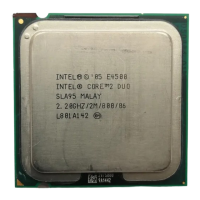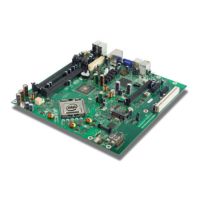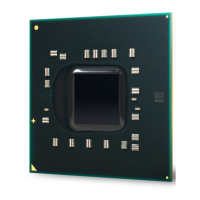Errata
54 Intel
®
Core™2 Extreme Processor X6800 and
Intel
®
Core™2 Duo Desktop Processor E6000 and E4000 Sequence
Specification Update
Implication: When this erratum occurs, a non-accessed page which is present in memory
and follows a page that contains the code segment limit may be tagged as
accessed.
Workaround: Erratum can be avoided by placing a guard page (non-present or non-
executable page) as the last page of the segment or after the page that
includes the code segment limit.
Status: For the steppings affected, see the Summary Tables of Changes.
AI91. Update of Attribute Bits on Page Directories without Immediate TLB
Shootdown May Cause Unexpected Processor Behavior
Problem: Updating a page directory entry (or page map level 4 table entry or page
directory pointer table entry in IA-32e mode) by changing read/Write (R/W)
or User/Supervisor (U/S) or Present (P) bits without immediate TLB
shootdown (as described by the 4 step procedure in "Propagation of Page
Table and Page Directory Entry Changes to Multiple Processors" In volume 3A
of the Intel
®
64 and IA-32 Architecture Software Developer's Manual), in
conjunction with a complex sequence of internal processor micro-architectural
events, may lead to unexpected processor behavior.
Implication: This erratum may lead to livelock, shutdown or other unexpected processor
behavior. Intel has not observed this erratum with any commercially
available software.
Workaround: None Identified.
Status: For the steppings affected, see the Summary Tables of Changes.
AI92. Invalid Instructions May Lead to Unexpected Behavior
Implication: Invalid instructions due to undefined opcodes or instructions exceeding the
maximum instruction length (due to redundant prefixes placed before the
instruction) may lead, under complex circumstances, to unexpected behavior.
Implication: The processor may behave unexpectedly due to invalid instructions. Intel has
not observed this erratum with any commercially available software.
Workaround: None identified.
Status: For the steppings affected, see the Summary Tables of Changes.
AI93. EFLAGS, CR0, CR4 and the EXF4 Signal May be Incorrect after
Shutdown
Problem: When the processor is going into shutdown due to an RSM inconsistency
failure, EFLAGS, CR0 and CR4 may be incorrect. In addition the EXF4 signal
may still be asserted. This may be observed if the processor is taken out of
shutdown by NMI#.
Implication: A processor that has been taken out of shutdown may have an incorrect
EFLAGS, CR0 and CR4. In addition the EXF4 signal may still be asserted.

